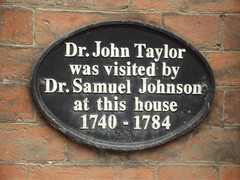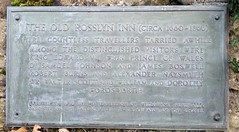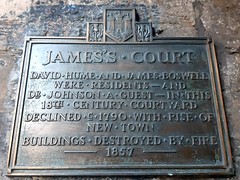

Dr Samuel Johnson
(1709-1784)
writer, Doctor (unknown type) (from 1765), and Doctor (unknown type) (from 1775)
Died aged 75
Wikidata WikipediaSamuel Johnson (18 September 1709 [OS 7 September] – 13 December 1784), often called Dr Johnson, was an English writer who made lasting contributions as a poet, playwright, essayist, moralist, critic, biographer, editor and lexicographer. The Oxford Dictionary of National Biography calls him "arguably the most distinguished man of letters in English history". Born in Lichfield, Staffordshire, he attended Pembroke College, Oxford until lack of funds forced him to leave. After working as a teacher, he moved to London and began writing for The Gentleman's Magazine. Early works include Life of Mr Richard Savage, the poems London and The Vanity of Human Wishes and the play Irene. After nine years' effort, Johnson's A Dictionary of the English Language appeared in 1755, and was acclaimed as "one of the greatest single achievements of scholarship". Later work included essays, an annotated The Plays of William Shakespeare, and the apologue The History of Rasselas, Prince of Abissinia. In 1763 he befriended James Boswell, with whom he travelled to Scotland, as Johnson described in A Journey to the Western Islands of Scotland. Near the end of his life came a massive, influential Lives of the Most Eminent English Poets of the 17th and 18th centuries. He was a devout Anglican, and a committed Tory. Tall and robust, he displayed gestures and tics that disconcerted some on meeting him. Boswell's Life, along with other biographies, documented Johnson's behaviour and mannerisms in such detail that they have informed the posthumous diagnosis of Tourette syndrome, a condition not defined or diagnosed in the 18th century. After several illnesses, he died on the evening of 13 December 1784 and was buried in Westminster Abbey. In his later life Johnson became a celebrity, and following his death he was increasingly seen to have had a lasting effect on literary criticism, even being claimed to be the one truly great critic of English literature. A prevailing mode of literary theory in the 20th century drew from his views, and he had a lasting impact on biography. Johnson's Dictionary had far-reaching effects on Modern English, and was pre-eminent until the arrival of the Oxford English Dictionary 150 years later. James Boswell's Life of Samuel Johnson was selected by Johnson biographer Walter Jackson Bate as "the most famous single work of biographical art in the whole of literature".
DbPedia
friend of Topham Beauclerk , founder of The Club and friend of James Boswell
Commemorated on 19 plaques
Essex Street was laid out in the grounds of Essex House by Nicholas Barbon in 1675. Among many famous lawyers who lived here were Sir Orlando Bridgeman c.1606-1674 Lord Keeper, Henry Fielding 1707-1754 novelist and Brass Crosby 1725-1793 Lord Mayor of London. James Savage 1779-1852 architect had his office here. Prince Charles Edward Stuart stayed at a house in the street in 1750. Rev Theophilus Lindsey 1723-1808 Unitarian Minister founded Essex Street Chapel here in 1774. Dr. Samuel Johnson established an evening club at the Essex Head in 1783.
Essex Hall, Essex Street, Westminster, WC2, London, United Kingdom where they established an evening club at the Essex Head (1783)
Immediately to the south of this building stood the house occupied by Hester and Henry Thrale where Samuel Johnson and Fanny Burney were frequent visitors
78 West Street, Brighton, United Kingdom where they visited
In a house on this site Doctor Samuel Johnson lived between 1765-1776
Johnson's Court, Fleet Street, London, United Kingdom where they lived
Dr. Samuel Johnson author lived here b. 1709 d. 1784
17 Gough Square, London, United Kingdom where they lived
Here in the former Turk's Head Tavern Dr Samuel Johnson & Joshua Reynolds founded The Club in 1764
9 Gerrard Street, London, United Kingdom where they founded The Club
The house in which Dr. Samuel Johnson, was born Born 1709. Died 1784. Educated at Lichfield Grammar School. Buried in Westminster Abbey.
Market Street, Lichfield, United Kingdom where they was born (1709)
Hodge 'a very fine cat indeed' belonging to Samuel Johnson (1709-1784) of Gough Square. 'Sir, when a man is tired of London he is tired of life:for there us in London all that life can afford.' 'The chief glory of every people arises from its authors'
Gough Square, London, United Kingdom where they lived near
On this site stood Dame Oliver's Infant School where Dr. Samuel Johnson was taught English 1714. Born 1709. Died 1784.
10 Dam Street, Staffordshire, WS13 6AA, Lichfield, United Kingdom where they attended school
Near this site stood the Culstrubbe Gate of the City, one of four gates erected by Bishop Roger de Clinton (1129-1148). These buildings erected in 1849, now the Council Chamber and offices of the Lichfield Rural District Council, were formerly the 16th century Grammar School and Headmaster's House where many famous men including, Johnson, Garrick, Addison and Ashmole were educated.
The Old Grammar School, St John Street, Lichfield, United Kingdom where they attended school
Dr Samuel Johnson Born in the City of Lichfield 1709 died 1784 this mosaic by John Myatt after a portrait by Sir Joshua Reynolds was donated to the Citizens of Lichfield in June 1976 by Lichfield District Arts Association and Berger Paints
off Bird Street (opposite New Minster House), Lichfield, United Kingdom where they portrayed
In this house occupied by Thomas Davies bookseller Dr. Samuel Johnson first met James Boswell in 1763
8 Russell Street, WC2, London, United Kingdom where they met James Boswell (1763)
James Boswell (1740-1795) and Dr Samuel Johnson (1709-1784) are reputed to have met and dined in this building circa 1770. James Boswell the Scot's writer was acclaimed for his literary classic "Life of Johnson" a biography of his illustrious friend Dr Samuel Johnson the learned scholar, philosopher and critic
Witchery Restaurant, Castlehill, Edinburgh, United Kingdom where they is reputed to have met and dined with James Boswell in this building (1770)
Boyds Inn. At which D. Samuel Johnson arrived in Edinburgh 14th August 1773. On his memorable tour to the Hebrides. Occupied the larger part of the site of this building.
Boyds Entry, Edinburgh, United Kingdom where they was (1773)
The Three Crowns. Dr Johnson frequently stayed here during his many visits to Lichfield. In 1776 he was accompanied by Boswell, who described him as "now monarchising with no fewer than three crowns over his royal brow".
Breadmarket Street, Lichfield, United Kingdom where they stayed
Richard Greene, Apothecary, Born 1716, Died 1793. Here he lived from 1760 to his death and hoed his celebrated museum which was inspected and admired by his relative Dr Samuel Johnson on his visits to Lichfield. It was to Richard Greene that Dr Johnson set the epitaph for his father's tombstone in 1784. His motto was "Nemo sibi vivat" (let no man live to himself)
Market Street, Lichfield, United Kingdom where they was
Dr. John Taylor was visited by Dr. Samuel Johnson at this house 1740-1784
The Mansion - Church Street, Ashbourne, United Kingdom where they visited (1740-1784)
The Old Rosslyn Inn (circa 1660-1866). Among the distinguished visitors were King Edward VII when Prince of Wales, Dr Samuel Johnson and James Boswell, Robert Burns and Alexander Naysmith, Sir Walter Scott, and William and Dorothy Wordsworth.
Chapel Loan, Roslin, United Kingdom where they visited
1834 Site of the Black Bull Inn visited by Johnson and Boswell on August 15th 1773
, Banff, United Kingdom where they visited (1773)
James's Court. David Hume and James Boswell were residents - and Dr Johnson a guest - in this 18th century courtyard. Declined c.1790 with rise of New Town. Buildings destroyed by fire 1857.
James's Court, Edinburgh, United Kingdom where they visited



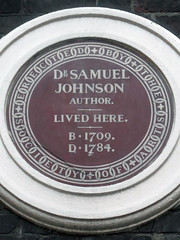
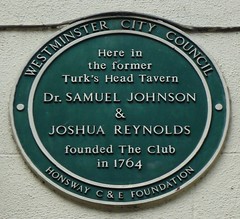


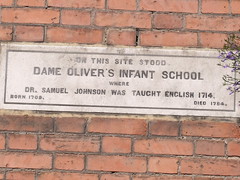

_Lichfield_Staffordshire_WS13_6PR.jpg?width=250)




